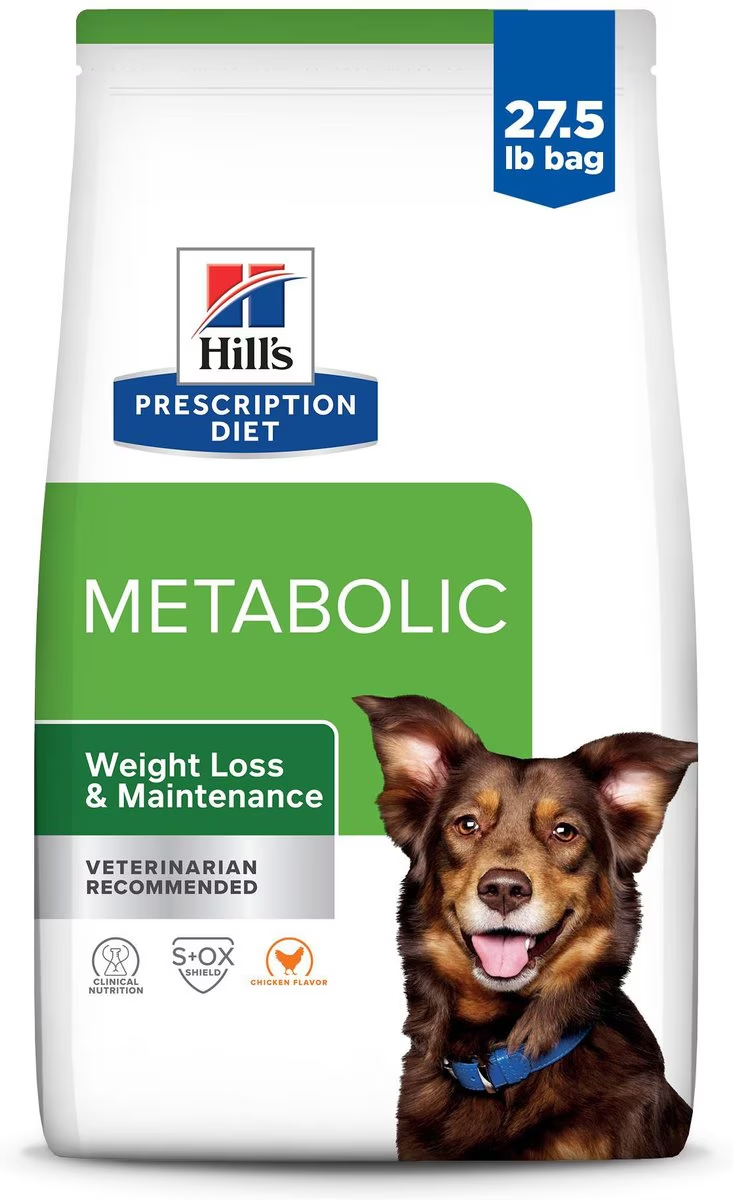
DogFoodAdvisor is reader supported See how
All reviews are 100% impartial but if you buy using links on this page, we may earn a referral fee.
Our Verdict
Hill’s Prescription Diet dry product range is made up of 34 recipes, they are not rated due to their intentional therapeutic design. All the recipes in Hill’s Prescription product range are designed for specific health conditions.
Although this is a prescription product, our review has nothing to do with the accuracy of claims made by the manufacturer as to the product’s ability to treat or cure a specific health condition.
So, to find out whether or not this Hill’s dog food is appropriate for your particular pet, it’s important to consult your veterinarian.
Pros
- Wide variety of recipes for specific needs
- More affordable than some high-end dog food
- Science led ingredients
Cons
- Recipes contain fillers and potentially controversial ingredients
The table below shows each recipe in this range and the AAFCO nutrient profile: Growth (puppy), Maintenance (adult), All Life Stages, Supplemental or Unspecified.
Ingredients Analysis
Hill’s Prescription Diet Metabolic Chicken Flavor Dog Food (formulated for weight loss & maintenance) has been chosen as a representative of the range, even though each recipe may be designed for different veterinary conditions.
The first ingredient is whole grain wheat. Whole grain wheat contains all the essential parts and naturally-occurring nutrients of the entire grain seed in their original proportions. If the grain has been processed (e.g., cracked, crushed, rolled, extruded, and/or cooked), the food product should deliver the same rich balance of nutrients that are found in the original grain seed.
Whole grain wheat contains fibres, carbohydrates, vitamins and minerals. Aside from its energy content, however, this whole grain cereal is of only modest nutritional value to a dog.
The second ingredient is corn. Corn is an inexpensive and controversial cereal grain. And aside from its energy content, this grain is of only modest nutritional value to a dog.
The third ingredient is chicken meal. Chicken meal is considered a meat concentrate and contains nearly 300% more protein than fresh chicken.
The fourth ingredient is powdered cellulose, powdered cellulose, an insoluble plant fiber usually made from the by-products of vegetable processing. As a fiber isolate cellulose can convey a number of functional benefits in the diet, from reducing the energy density and promoting satiety in a weight control diet, to supporting digestion and dental health.
The fifth ingredient is soybean oil is red flagged here only due to its rumored (yet unlikely) link to canine food allergies.
However, since soybean oil is high in omega-6 fatty acids and contains no omega-3’s, it’s considered less nutritious than flaxseed oil or a named animal fat.
The sixth ingredient is corn gluten meal. Gluten is the rubbery residue remaining once corn has had most of its starchy carbohydrate washed out of it.
Although corn gluten meal contains 60% protein, this ingredient would be expected to have a lower biological value than meat.
And less costly plant-based products like this can notably boost the total protein reported on the label – a factor that must be considered when judging the actual meat content of this dog food.
The seventh ingredient is beet pulp. Beet pulp is a controversial ingredient, a high fiber by-product of sugar beet processing.
Some denounce beet pulp as an inexpensive filler while others cite its outstanding intestinal health and blood sugar benefits.
We only call your attention here to the controversy and believe the inclusion of beet pulp in reasonable amounts in most dog foods is entirely acceptable.
The eight ingredient is tomato pomace. Tomato pomace is a by-product remaining after processing tomatoes into juice, soup and ketchup. Many praise tomato pomace for its high fiber and nutrient content, while others believe it’s often used as an inexpensive pet food filler.
As the presence of fiber in a dog’s diet is shown to have great importance, we view the inclusion of tomato pomace in this food as a positive.
From here the list goes on to include a number of other items. But to be realistic, ingredients located this far down the list (other than nutritional supplements) are not likely to affect the overall rating of the product.
This recipe has two notable exceptions.
Taurine, an essential amino acid for dogs associated with the healthy function of heart muscle. Although taurine is not typically considered essential in canines, some dogs have been shown to be deficient in this critical nutrient.
Since taurine deficiency appears to be more common in pets consuming grain-free diets, we view its presence in this recipe as a positive addition.
Next, this recipe contains sodium selenite, a controversial form of the mineral selenium. Sodium selenite appears to be nutritionally inferior to the more natural source of selenium found in selenium yeast.
hills Dog Food Recall History
The following automated list (if present) includes all dog food recalls related to hills through April 2025.
- Hill’s Prescription Diet and Science Diet Dog Food Recall Expands to Include 44 Varieties (March 20, 2019)
- Hill’s Prescription Diet and Science Diet Dog Food Recall (January 31, 2019)
- Hill’s Science Diet Dog Food Market Withdrawal of November 2015 (November 29, 2015)
- Hill’s Science Diet Dog Food Recall June 2014 (June 3, 2014)
You can view a complete list of all dog food recalls since 2009 here.
Our Rating of Hill's Prescription Diet Dry Dog Food
Hill’s uses qualified experts to formulate its products in one of the world’s leading research facilities. There are blends that are great for dogs of all ages, from puppies to seniors as well as recipes to suit dogs with health conditions such as diabetes, obesity and a sensitive stomach.
About
Hill’s Pet Nutrition is an international pet food brand that’s known for selling scientifically developed foods.
In 1948, Hill’s officially went into business. Dr. Mark Morris Sr. teamed up with Topeka-based Hill Packing Company to can his recipe, Canine k/d, and produce new pet food formulas.
In 1968, Hill’s launched its Science Diet range under the guidance of Mark Morris Jr. In 1976, Colgate-Palmolive Co. purchased Hill’s Pet
Nutrition. Today, Hill’s products are available in 86 countries worldwide.
It now employs a team of more than 220 veterinarians, nutritionists, technicians, and food scientists to develop pet foods in the Hill research facility that’s still located in Topeka.
Compare Hill's Prescription Diet Dry Dog Food
How does Hill's Prescription Diet Dry compare with The Dog Food Advisor's most recommended brands?
A Final Word
The Dog Food Advisor does not accept money, gifts, samples or other incentives in exchange for special consideration in preparing our reviews.
However, we do receive a referral fee from online retailers (like Chewy or Amazon) and from sellers of perishable pet food when readers click over to their websites from ours. This helps cover the cost of operation of our free blog. Thanks for your support.
For more information, please visit our Disclaimer and Disclosure page.





